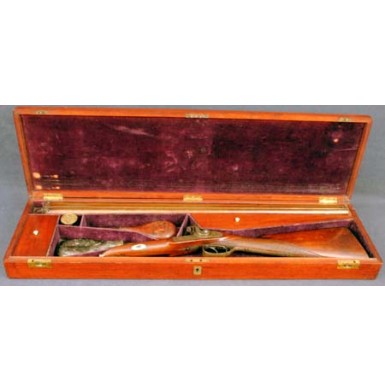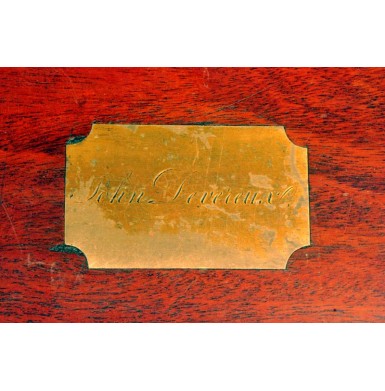ID'd Double Barrel Shotgun - Major Deverux -69th PA Infantry
- Product Code: FLA-1389-SOLD
- Availability: Out Of Stock
-
$1.00
I don’t normally offer antique sporting arms from the Civil War era. However, this wonderful percussion shotgun was owned by a famous US military officer and is a great example of the type of cased, high end sporting arms that were common with upper class in America during the mid-19th Century. The shotgun offered here was the property of John Devereux of Philadelphia, PA. Mr. Devereux appears in the 1860 US Census listed as an imported of wins & liquors with real estate holdings valued at $10,000 and total worth of $16,000! According to the census he was 31 at the time (born in 1829) , was born in Pennsylvania and resided in the 22nd Ward of Philadelphia. Mr. Devereux appears in the 1857 Philadelphia business directory listed only as a merchant. With the coming of the American Civil War, John Devereux volunteered to fight for the Union and was mustered into the 24th PA Infantry, a three-month regiment, as its Major. The regiment was formed on May 1, 1861 and was mustered out on August 10, 1861. Devereux, along with Colonel Joshua T Owen of the 24th PA formed a new regiment just a week later and on August 18, 1861 the 69th Pennsylvania Volunteer Infantry was mustered into service in the 22nd Ward of Philadelphia with Colonel Owens leading it and with John Devereux as Major. The 69th Pennsylvania Volunteer Infantry fought with the Army of the Potomac in every major battle and through all the campaigns of that army from the summer of 1861 through the end of the war. Major Devereux was clearly in the thick of things, as he is listed as wounded at Richmond, VA on July 18, 1862 (in the aftermath of the Seven Days) and was subsequently wounded at Antietam on September 17, 1862. On December 1, 1862 Devereux was promoted to Lt. Colonel but was never mustered in at that rank, so it is possible that he never returned to the regiment due to his wounds, or the promotion was only a brevet promotion that was never acted upon. The 62nd PA went on to fight all of the major Army of the Potomac battles, including Fredericksburg, Chancellorsville, Gettysburg, The Wilderness, Spotsylvania, Cold Harbor, The Siege of Petersburg, Sailor’s Creek and Appomattox Courthouse, just to name the high-points! The 69th was one of the regiments that saw the brunt of the fighting at the Union center on July 3, 1863 during Pickett’s Charge. Major Devereux ended his military career with a short stint in the 21st Regiment, Veteran Reserve Corps which mustered in on January 12, 1865 and mustered out on November 20, 1865.The shotgun is a very high quality, US retailed fowler, cased in a fine mahogany case with the name John Devereux engraved on a brass name plate on the top of the case. The rib of the gun, between the barrel is retailer marked J S & J PHILA. I have not been able to identify the retailer. The gun, like almost every American fowler of the period, uses imported barrels, which are marked with Belgian proofs on the bottom. The assembly number 223 appears on the bottom of the barrels and inside both locks. Most fowlers of the period utilized back action locks, which were cheaper and simpler to manufacture. This gun uses high-grade front action locks, that are both still very crisp and works as well as the day the gun was built. The locks, hammers and most of the iron furniture are decorated with nice quality decorative scroll engraving. The decorative metal work, especially the iron finals on the trigger guard and fore end are in the classic Philadelphia style, and the engraving is reminiscent of Henry Deringer's work on his pistols of the same time period. The barrels of the takedown shotgun are secured by a hook breech and with a single key, which is inserted through German Silver mounted escutcheons. The gun is a classic upland game gun with side-by-side 12 gauge barrels that are 31” in length. The barrels are smooth metal, with the only roughness being some light pinprick pitting around the cones (nipples) at the breach. The barrels retain strong remnants of a Damascus Twist pattern, which was likely an applied finish, intended to duplicate the look of expensive Damascus barrels, and not true Damascus Twist construction. The bores of the barrels are dark and dirty with light scattered pitting, and would likely improve greatly after a good scrubbing with a brass brush. The original brass tipped, wooden ramrod is secured in iron pipes under the barrels. The rammer has a cleaning jag at the opposite end. The checkered wooden stock is in very good condition, with strong, sharp checkering at the wrist and only the normal assortment of bumps, dings and rubs that would be expected from a sporting gun that has seen use. There is one 4” long vertical scrape on the right hand side of the stock that is only a dent and does not penetrate the surface of the wood. The entire gun is covered with a light and very old coating of varnish, which has protected all of the metal from corrosion and damage, and has likewise kept the stock in very fine condition as well.
The shotgun is housed in its original brass mounted, Mahogany case with accessory compartments, which is lined with a lovely dark purple, velvet like material. The case has two flush mounted sliding catches on the front, as well as a key lock. The key is no longer with the set. The case is in very good to fine condition and even retains the original lids for two of the compartments, complete with ivory knobs. The case includes the original brass deer scene powder flask (appears to be Riling #983), which is unmarked except for the word Patented on the top. The flask is heavily dented and has very dark, un-cleaned patina to the brass. The original leather shot charging pouch is included as well (Riling #1458) and still has quite a bit of shot in it. The pouch is marked 2 “ lbs. A partially full japanned tin of Eley Brothers percussion caps in present in the case, as are a large quantity of over powder and over shot wads. The original brass mounted, 3-piece wooden cleaning rod is present as well. It has a post percussion era, cartridge shotgun barrel scraping tool threaded onto its end. The tool is not appropriate to the set, but makes a nice display item and is well marked with patent names and dates. A small glass vial, with a jagged pontil mark on the bottom and a cork stopper is also in the compartment with the shotgun wads. It is very rare to find an American retailed shotgun from this era complete with a case and accessories and this are all in very nice, displayable condition.
As noted, most American fowlers of this era were simple, back action lock guns without any decoration or adornment. This high grade American shotgun is a rare item with engraved metal, a checkered stock, Damascus pattern barrels and a full case with accouterments. The quality of the shotgun is wonderful and the overall eye-appeal of the entire set is quite fine. The fact that the gun was owned by a rather wealthy and successful Philadelphia businessman who went on to great glory during the American Civil War, in a hard fought regiment, just adds to the great appeal of this set. It would be more than worth the time and effort to obtain Major Devereux’s records from the National Archives to add to the display. A small binder with copies of Devereux’s Census listing, Philadelphia directory listing, some of his service history and some history of the 69tth PA, 24th PA and 21st Regiment Veteran’s Reserve Corps, is included with the gun to provide the base for further research on this American Hero. Identified items of this quality and with this level of personality and displayability are rarely encountered in today’s Civil War collecting market and this would be a wonderful addition to any fine Civil War collection.
Due to the size and weight of the case, along with the accessories and the gun, extra shipping will apply.
SOLDTags: IDd, Double, Barrel, Shotgun, Major, Deverux, 69th, PA, Infantry





